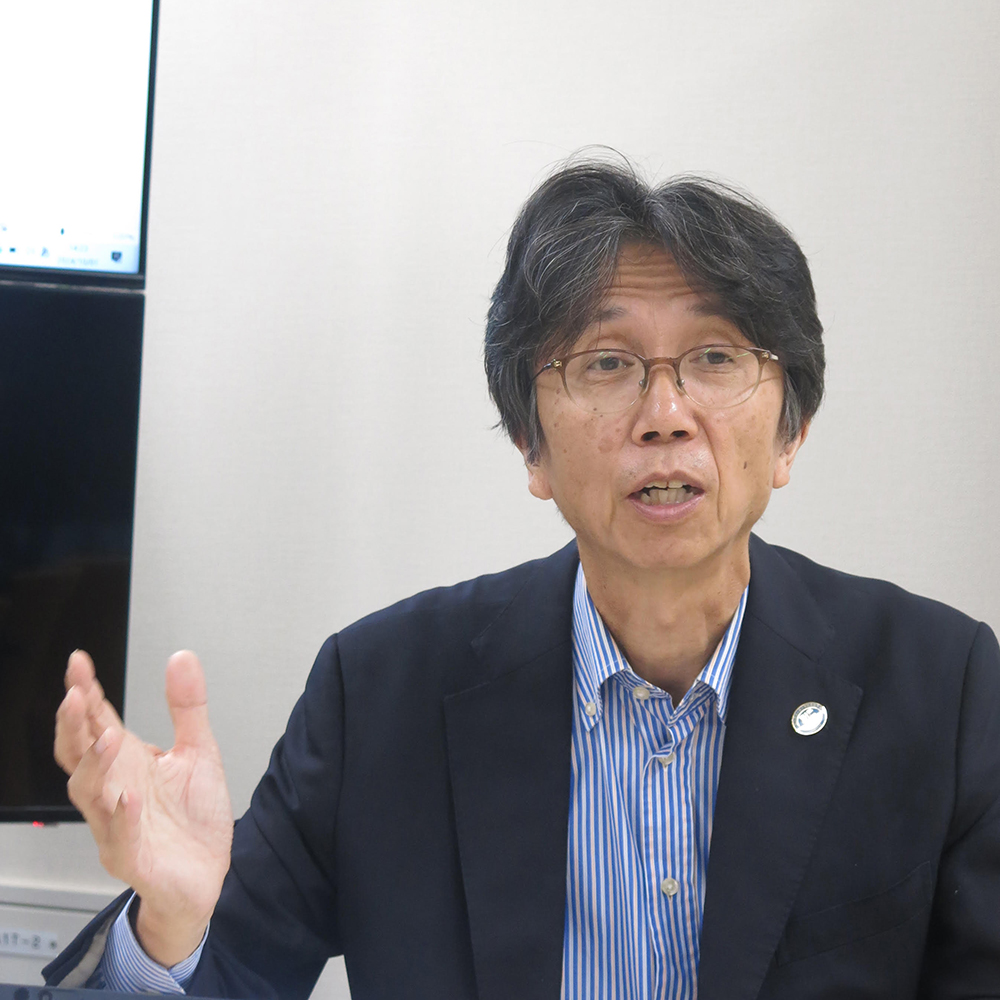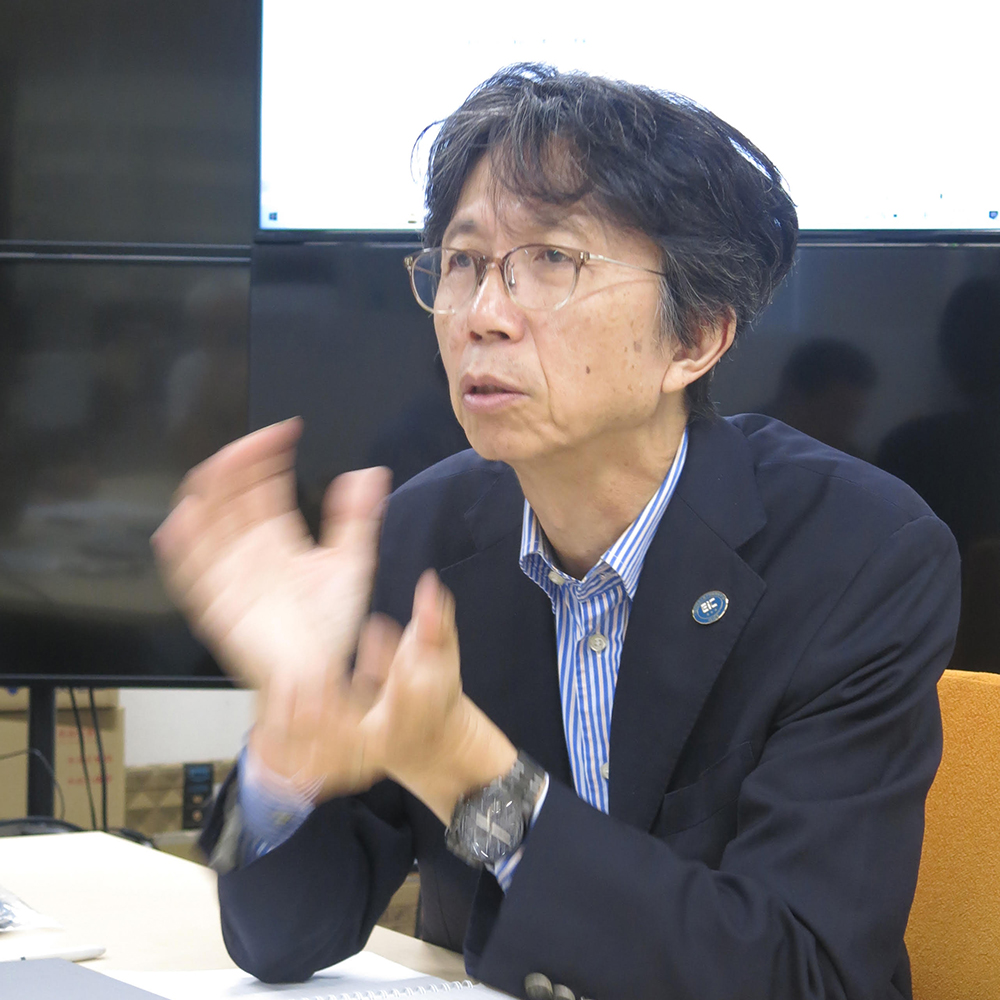The Significance of B5G Research and Development
Expectation for Expanding B5G R&D Landscape and Cultivating “Super Players”
Naoaki Yamanaka, Ph.D(Engineering)
President of the Institute of Electronics, Information and Communication Engineers
Project Professor at Keio University
How will society change with Beyond 5G ? What path should Japan take in global society? We asked these questions to Professor Naoaki Yamanaka, President of the Institute of Electronics, Information and Communication Engineers and editor of “The Future Envisioned by Beyond 5G: Technology, Lifestyle, and Business in 2030 ” (Keio University Press).
What are the differences between 5G and Beyond 5G?
What do you think are the clear differences between 5G and Beyond 5G (B5G)?

Yamanaka: It would be easy if I could say “5G is like this and 6G will be like that,” but unfortunately that’s not the case.
Looking back over the past decade or so, the importance of the virtual world has grown steadily in relation to the real world. If this trend continues, it will become possible to grasp the real-time state of the entire planet in cyberspace.
Currently, statistical data in text form is referred to as big data. In the future, real-time screens and photos will be converted into big data, becoming much more dynamic than before and generating so much data every second that it will be impossible to process. This is sometimes referred to as the “dynamic big data” era.
In the dynamic big data era, the following scenario becomes possible. Suppose several cars are approaching an intersection where a pedestrian is about to cross the crosswalk. If nothing is done, it is predicted that a car will hit the pedestrian in 15 seconds. In this case, it becomes possible to automatically stop the car predicted to hit the pedestrian and prevent the accident. With a car, you can predict where it will be in 15 seconds because you know its current position and speed. If it were a cat, you could not predict that.

This is an example of how the virtual world makes the real world safer and smarter. However, the sensors used in this technology and the surveillance cameras that upload real-world data into cyberspace are not unique to B5G; they have already been achieved with 5G.
Additionally, as it stands now, when you want to go to Station A, route information will optimize the shortest route for you in terms of which train to take and where to board. However, it would cause congestion if the same route information was provided to everyone, so certain rules will likely be established to distribute the congestion load. This is also just an advancement of the current method, so it is difficult to say where B5G begins.
It's difficult to draw a clear distinction, but would it be fair to say that the virtual world will lead the real world and design the future in the most efficient and optimal way possible?
Yamanaka: We are working to create an even safer, smarter, and more energy-efficient society than is possible with 5G with the help of more advanced support from computers and networks. The virtual world will be idealized first, and then it will control the real world. Edge computing, IoT, sensor networks, AI, and other technologies will be leveraged to make this a reality. However, some people say that the technologies expected to be realized in 2030 are actually already available today.
What Japanese technologies can we expect to see in Beyond 5G?
In the future B5G market, which areas do you think Japan's technologies are likely to have a competitive advantage in?
Yamanaka: I believe that Japan's technological excellence lies in its advanced hardware and complex, integrated systems. As technology becomes more integrated, it will become essential to coordinate materials, devices, modules, systems, networks, applications, and businesses. Japan, with its tradition of teamwork, is well positioned to create such an ecosystem.
Next is energy conservation and sustainability, which are important factors. I believe that Japan excels at calmly and carefully exploring technologies that are truly important. When it comes to low power consumption, Japan's strengths lie not only in materials and devices, but also in important technologies such as usage methods and careful energy management.
What is expected of academic societies and industries?
What do you think Japanese academic societies and industries need to be aware of and work toward to realize B5G in the 2030s?
Yamanaka: Academic societies and industries are fundamentally different entities. First, with regards to academic societies, as President of the Institute of Electronics, Information and Communication Engineers, I would like more people to understand the meaning of academic societies. If you are only looking for short-term information, you can find it by searching the web. Collaboration with people from different industries, companies, and fields of expertise, on the other hand, is not so easy. In this context, academic societies are communities where many such encounters take place. In that sense, it is important for engineers in Japan to make efforts to participate in national projects, promote industry-academia collaboration, and form teams to work together.
In industries, people must compete in pursuit of short-term profits. Therefore, I believe we should make greater use of the power of society. “Not invented here”—the tendency to reject outside ideas—is an old saying, but it still exists in the industries. Let's make collaboration and cooperation keywords and be proactive in borrowing the strengths of others. As open science progresses, industries must focus on incorporating good ideas in order to grow. Rather than aggressively acquiring other companies, industries should aim to create “ONE TEAM” like in Japanese rugby with the goal of winning.
What path should Japan take toward the Beyond 5G era?
What do you think Japan needs to do to lead the world in introducing B5G in the 2030s?
Yamanaka: I don't think there are any problems with technology. Japan is not lagging behind the rest of the world. It's not that we are outstandingly superior either, mind you. People with similar abilities are investing similar amounts of time, so I don't see any problems with Japan improving its international competitiveness in terms of technology.
The issue Japan needs to consider is its social problems. When people hear the phrase, “Let's create a society that actively takes on new challenges,” most people agree with it in principle. However, when they actually take on a challenge and fail, they are criticized by those around them and attacked so severely that they are unable to recover. People criticize based only on results. This leads many people to believe that it is better not to take on challenges at all than to risk taking them on and failing. Additionally, while many people say that “individuality must be valued,” in practice, those who stand out are often dismissed as lacking in teamwork.


Perhaps due to these trends, Japanese students aim to find employment at large companies. In the U.S., on the other hand, many students want to start their own businesses in the future. They have a strong desire to be entrepreneurs. For this reason, it is not uncommon for them to work at a company for three years or so to gain expertise. Rather than working for someone else their entire lives, many students have ambitions to take a chance for success while they are young, retire early, and enjoy their lives. The way Japanese and American students think is fundamentally different.
In the B5G field, it is essential that “super players” emerge.
Even with the same skills and approach, only a few become “super players”. Success and failure are determined by a combination of factors; perhaps some were not lucky enough to have friends who helped them, or their skills did not catch the public's eye. Behind every super player, there may be dozens or even hundreds of people who did not make it. However, even if not everyone becomes a “super player”, outstanding players will emerge from among those who did not make it, and some of them will start venture companies that grow in their own unique ways. Alternatively, they may apply the skills they have acquired in other fields.
Of course, the ideal and most straightforward path is for efforts to lead directly to success. However, failure does not mean that the results are zero. I believe that what companies and students learn, compete in, and experience now will surely be put to good use in 2030. Even if an approach does not work, learning this can still be considered a positive result. From this perspective, I think it is wonderful that society is currently investing in B5G. From here, I think we will see the emergence of people who strongly assert themselves and pioneer new fields, which has been difficult in Japan's traditional culture until now.
How do you think B5G will be used going forward?
Yamanaka: I believe that biotechnology, energy, and SDGs-related fields are particularly important. Among these, how to address energy issues in light of recent climate change is a major issue. B5G has the potential to contribute to solving such issues through its energy-saving capabilities.

